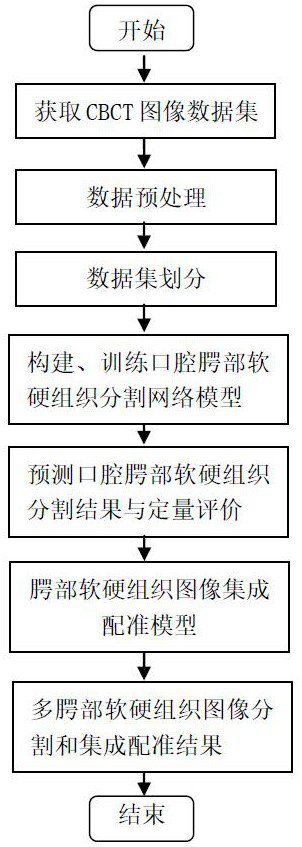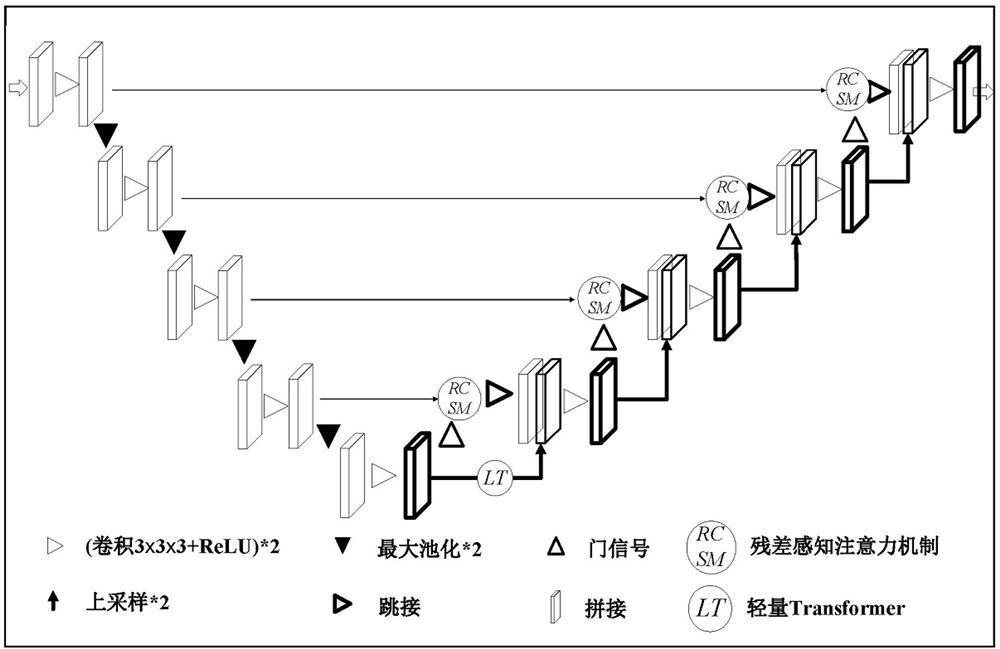Oral palate soft and hard tissue segmentation method based on attention mechanism and integrated registration
A technology of attention and oral cavity, which is applied in the interdisciplinary field of stomatology and computer science, can solve the problems of inaccurate tissue segmentation and large individual differences in CBCT images, so as to solve the problem of individual differences, reduce the time of implantation sites, and reduce the network The effect of increasing the number of parameters
- Summary
- Abstract
- Description
- Claims
- Application Information
AI Technical Summary
Problems solved by technology
Method used
Image
Examples
Embodiment 1
[0052] A method for automatic segmentation of soft and hard tissues in the oral cavity and palate provided by this embodiment, the overall flow diagram is shown in figure 2 , the main steps include: data acquisition, model building, model training and model network testing.
[0053] 1. Data acquisition, specifically including the following steps:
[0054] (a) Collect a data set, including CBCT images and soft and hard tissues of the oral and palate outlined by doctors;
[0055] (b) Preprocessing the target image data set, wherein the target image data set includes a CBCT image data set and a delineation label data set, and the preprocessing includes:
[0056] Normalized. Image normalization is a pixel-level operation. Different CBCT scanning equipment may have different configurations. In order to eliminate differences, these images are normalized. The formula is as follows:
[0057] (13)
[0058] where x i Represents the image pixel point value, min(x), max(x) repres...
Embodiment 2
[0104] Firstly, the target image data set is preprocessed, wherein the target image data set includes a CBCT image data set and a delineation label data set, and the preprocessing includes: normalization, grayscale and ROI extraction.
[0105] Secondly, the random augmentation method is added to the segmentation network model training to take all possible types of transformations, the number of sequentially applied enhancement transformations, and the magnitude of all transformations into the algorithm. The augmentation transformation methods include X-axis translation and Y-axis translation. , X-axis shearing, Y-axis shearing, and image rotation. The augmenting transformation strengths include constant amplitude, random amplitude, linearly increasing amplitude, and random amplitude with an increasing upper limit. The before and after comparison of the augmented data is as follows: the structural similarity of the segmented soft and hard tissues of the palate before adding rand...
PUM
 Login to View More
Login to View More Abstract
Description
Claims
Application Information
 Login to View More
Login to View More - R&D
- Intellectual Property
- Life Sciences
- Materials
- Tech Scout
- Unparalleled Data Quality
- Higher Quality Content
- 60% Fewer Hallucinations
Browse by: Latest US Patents, China's latest patents, Technical Efficacy Thesaurus, Application Domain, Technology Topic, Popular Technical Reports.
© 2025 PatSnap. All rights reserved.Legal|Privacy policy|Modern Slavery Act Transparency Statement|Sitemap|About US| Contact US: help@patsnap.com



